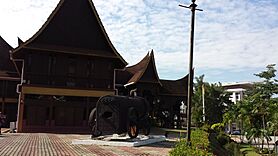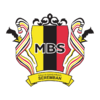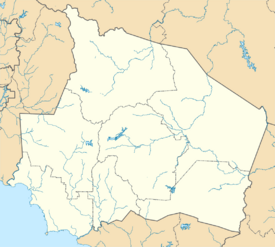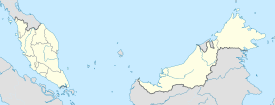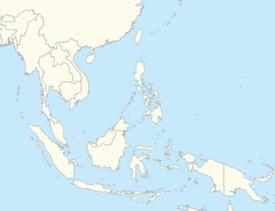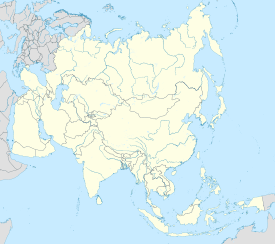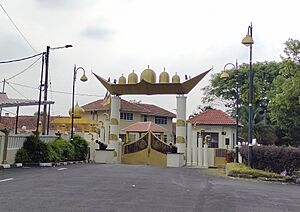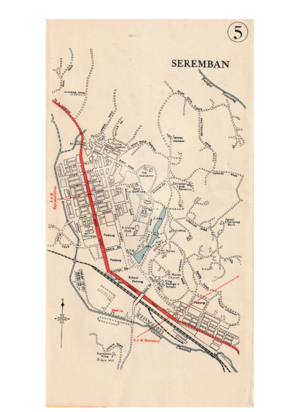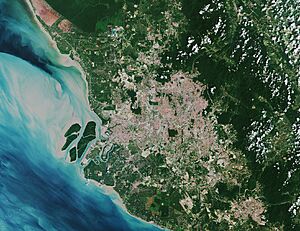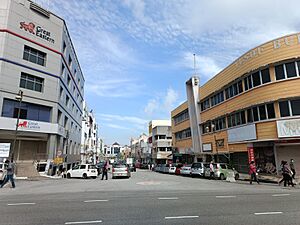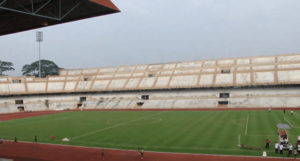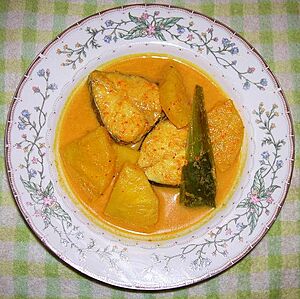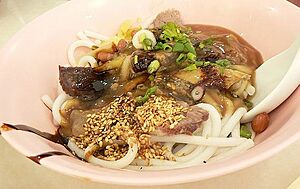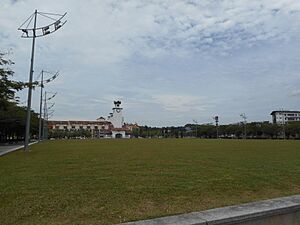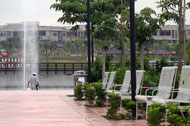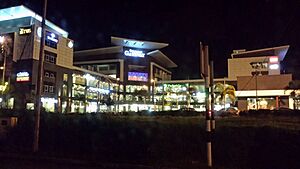Seremban facts for kids
Quick facts for kids
Seremban
Soghomban
Sungai Ujong
|
|||
|---|---|---|---|
|
State capital city and district capital
|
|||
| City of Seremban Bandaraya Seremban |
|||
| Other transcription(s) | |||
| • Jawi | سرمبن | ||
| • Mandarin | 芙蓉 (Simplified) 芙蓉 (Traditional) Fúróng (Hanyu Pinyin) |
||
| • Cantonese | fu4 jung4 (Jyutping) fùh-yùhng (Yale Romanisation) |
||
| • Tamil | சிரம்பான் Cirampāṉ (Transliteration) |
||
|
From top, clockwise:
Downtown skyline, the Wisma Negeri, Seremban Square, Lorong Seni, the State Museum, the State Library Building and War Memorial, the Seremban Jamek Mosque, and Jalan Tuanku Munawir |
|||
|
|||
| Nickname(s):
S'ban, Bandaraya Beradat ('City of Customs')
|
|||
| Motto(s):
Mampan. Bersih. Sejahtera.
"Sustainable. Clean. Prosperous." |
|||
| Country | |||
| State | |||
| District | Seremban | ||
| Luak | |||
| Establishment | 1840 | ||
| Establishment of the local government | 1897 | ||
| Establishment of the town board | 1946 | ||
| Establishment of the town council | 1953 | ||
| Municipality status | 1 March 1979 | ||
| City status | 20 January 2020 | ||
| Government | |||
| • Type | City council | ||
| • Body | Seremban City Council | ||
| Area | |||
| • State capital city and district capital | 959 km2 (370 sq mi) | ||
| • Metro | 2,980 km2 (1,150 sq mi) | ||
| Elevation | 79 m (259 ft) | ||
| Population
(2015)
|
|||
| • State capital city and district capital | 620,100 (9th) | ||
| • Density | 489.00/km2 (1,266.51/sq mi) | ||
| • Metro | 824,300 | ||
| • Demonym | Serembanite Serembanese (less common) |
||
| Time zone | UTC+8 (MST) | ||
| • Summer (DST) | Not observed | ||
| Postal code |
70xxx, 71xxx
|
||
| Mean solar time | UTC + 06:46:48 | ||
| National calling code | 06 | ||
| License plate prefix | Nxx (for all vehicles include taxis) | ||
| ISO 3166-2 | MY-05 | ||
Seremban is a lively city in Malaysia. It is the capital of the state of Negeri Sembilan. The city is located on the Malay Peninsula.
Seremban is managed by the Seremban City Council. It officially became a city on January 20, 2020.
Contents
- What's in a Name? The Story of Seremban's Name
- A Look Back: Seremban's History
- Seremban's Location and Weather
- Getting Around: Transportation in Seremban
- Who Lives Here? Seremban's Population
- Culture and Traditions in Seremban
- Parts of Seremban: City Areas
- Seremban's Economy
- Healthcare in Seremban
- Famous People from Seremban
- Sister Cities
- See also
What's in a Name? The Story of Seremban's Name
|
Sungai Ujong
|
|
|---|---|
| Luak Sungai Ujong لواق سوڠاي اوجوڠ |
|
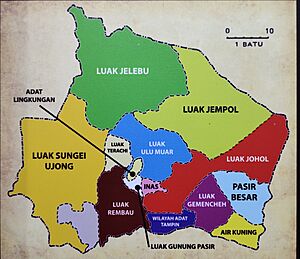
Luak of Sungai Ujong relative to other luaks in Negeri Sembilan
|
|
| Country | Malaysia |
| State | Negeri Sembilan |
| Adat institution | Undang of Sungai Ujong |
Seremban was first known as Sungei Ujong or Sungai Ujong. Even though the town's name changed to Seremban, "Sungai Ujong" is still used. You can find it as a street name in the southern part of the city.
It is also the name of a luak (a traditional chiefdom). This luak covers the Seremban District and the nearby Port Dickson District.
Chinese speakers call the city "fùhyùhng" (Cantonese) or "fúróng" (Mandarin). This name means "hibiscus". It sounds similar to "Ujong" when spoken in Cantonese.
A Look Back: Seremban's History
Seremban, originally called Sungai Ujong, is a very old settlement. Ancient stories say that King Parameswara visited Sungai Ujong. This was before he founded the Malacca Sultanate.
The town grew quickly in the 1870s. This happened after tin ore was found nearby. Many people came to work in the mines and trade.

Seremban became a busy center for mining and business. The Linggi River was important for moving tin and supplies. The town earned money from tin trade and taxes.
Local leaders, Dato' Kelana and Dato' Shahbandar, argued over who could collect taxes. This led to the British colonialists getting involved. The British helped Dato' Kelana, and he accepted a British advisor. This advisor would help with all matters except religion and Malay customs.
Captain Murray was the first British advisor. He set up his home in what is now Jalan Dato' Siamang Gagap. People moved closer for safety and better management.
Becoming a City: Seremban's Journey
Before 2020, Seremban was one of the few state capitals not yet a city. To become a city, the local councils of Nilai and Seremban needed to combine. This plan was approved in 2012.
Leaders wanted to make sure the city had good transport and services. This included things like garbage collection and safe neighborhoods.
On December 13, 2017, it was announced that Seremban would become a city in 2018. The two councils would merge into the new Seremban City Council. The leaders promised that this would not mean higher taxes for residents.
The official declaration of Seremban as a city was delayed a few times. It finally happened on January 20, 2020. The Seremban City Council officially began its work on January 1, 2020.
Seremban's Location and Weather
Seremban is about 60 kilometers south of Kuala Lumpur, Malaysia's capital. It is also about 30 kilometers inland from the coast. Seremban is part of a growing area called the Malaysia Vision Valley.
The city is in the Linggi River valley. It sits at the edge of the Titiwangsa Mountains. The land is mostly hilly with reddish soil. This soil is good for growing rubber and palm oil. So, Seremban is an important farming center for the state.
The Linggi River was very important for tin traders in the past. Today, it provides water for Seremban and Negeri Sembilan.
Seremban has a hot and humid (tropical) climate. The average temperature is about 26–30 degrees Celsius. Most rain falls in April and October. The rest of the year is generally dry with some showers.
| Climate data for Seremban | |||||||||||||
|---|---|---|---|---|---|---|---|---|---|---|---|---|---|
| Month | Jan | Feb | Mar | Apr | May | Jun | Jul | Aug | Sep | Oct | Nov | Dec | Year |
| Mean daily maximum °C (°F) | 30.9 (87.6) |
31.7 (89.1) |
32.5 (90.5) |
32.2 (90.0) |
31.7 (89.1) |
31.3 (88.3) |
31.1 (88.0) |
30.9 (87.6) |
31.2 (88.2) |
31.2 (88.2) |
31.0 (87.8) |
31.0 (87.8) |
31.4 (88.5) |
| Daily mean °C (°F) | 26.6 (79.9) |
27.2 (81.0) |
27.7 (81.9) |
27.8 (82.0) |
27.5 (81.5) |
27.1 (80.8) |
26.9 (80.4) |
26.8 (80.2) |
26.9 (80.4) |
27.0 (80.6) |
26.9 (80.4) |
26.8 (80.2) |
27.1 (80.8) |
| Mean daily minimum °C (°F) | 22.3 (72.1) |
22.7 (72.9) |
22.9 (73.2) |
23.4 (74.1) |
23.4 (74.1) |
23.0 (73.4) |
22.7 (72.9) |
22.8 (73.0) |
22.7 (72.9) |
22.8 (73.0) |
22.9 (73.2) |
22.6 (72.7) |
22.9 (73.1) |
| Average precipitation mm (inches) | 114 (4.5) |
110 (4.3) |
178 (7.0) |
232 (9.1) |
180 (7.1) |
119 (4.7) |
127 (5.0) |
143 (5.6) |
158 (6.2) |
237 (9.3) |
252 (9.9) |
193 (7.6) |
2,043 (80.3) |
| Source: Climate-Data.org | |||||||||||||
Getting Around: Transportation in Seremban
Trains and Flights
The first train line was built in the late 1890s. Seremban was a stop on the main line from Kuala Lumpur to Singapore. Today, the Seremban railway station is still a major stop.
It is also the southern end of the KTM Komuter train network. This connects Seremban to Kuala Lumpur and the Klang Valley.
Negeri Sembilan does not have its own airport. However, the Kuala Lumpur International Airport (KLIA) is less than 30 minutes away. This makes it closer to Seremban than to Kuala Lumpur.
Roads and Highways
Federal Route 1 is an old road that connects towns on the West Coast. It runs through Seremban. This road links Seremban to Rembau and Tampin in the south. To the north, it connects to Kajang, Selangor.
Seremban also has access to other towns through different federal routes. For example, Kuala Klawang is reached via Federal Route 86. Kuala Pilah is to the east via Federal Route 51. The coastal town of Port Dickson is to the west via Federal Route 53 or the SPDH.
The North–South Expressway has four exits for Seremban. The LEKAS Highway connects Kajang to Paroi in Seremban.
Who Lives Here? Seremban's Population
In 2020, almost 700,000 people lived in the Seremban district. This is more than half of Negeri Sembilan's total population.
The population includes:
- 56.4% Bumiputera (native people of Malaysia)
- 26.2% Chinese
- 17% Indian
- 0.5% other groups
There are also about 41,026 non-citizens.
| Ethnic groups in Seremban, 2010 census | ||
|---|---|---|
| Ethnicity | Population | Percentage |
| Bumiputera | 290,282 | 52.2% |
| Chinese | 134,572 | 24.2% |
| Indian | 87,663 | 15.8% |
| Others | 2,392 | 0.4% |
| Non-citizens | 41,026 | 7.4% |
| Total | 544,935 | 100% |
Culture and Traditions in Seremban
Seremban is a center for Minangkabau culture in Malaysia. The Minangkabau people are known for their unique roof designs. These roofs look like buffalo horns. Many buildings in Seremban have this design. Examples include the Seremban City Hall and the State Museum.
People in Negeri Sembilan follow a special custom called Adat Perpatih. This custom is matrilineal, meaning family lines are traced through the mother. Negeri Sembilan is the only state in Malaysia that follows this tradition. Most other Malaysian states follow Adat Temenggung, which is patrilineal (traced through the father).
Sports in Seremban
Seremban is home to the Negeri Sembilan FC football team. This team represents Negeri Sembilan in the Malaysia Super League. They play their home games at the Tuanku Abdul Rahman Stadium. This stadium can hold 45,000 people. It is located in Paroi, on the eastern edge of the city.
Delicious Food: Seremban's Cuisine
Seremban is famous for its special foods. These include Malay, Chinese, and Indian dishes.
One popular local food is Seremban Siew Pau. This is a flaky pastry bun. It is filled with meat, usually pork or chicken.
Seremban is also known for its Nasi Padang. This is a meal of rice served with dishes from Padang, Sumatra. A local favorite is Gulai Masak Lemak Cili Api. This dish has fish or meat cooked in coconut gravy with turmeric and cili padi (bird's eye chili).
You can also find delicious baked crabs and beef noodles in Seremban. The beef noodles are especially famous. They have a thick, flavorful gravy with peanuts and other toppings.
For desserts, try ABC (shaved ice with syrup and toppings) or cendol. Many people say Seremban's cendol is even better than the famous Teochew cendol from Penang.
Fun Places to Visit: Tourism in Seremban
Seremban Square Seremban Square is a newly improved open area in downtown Seremban. It used to be an empty space. Now, it is a beautiful spot that attracts visitors. The Malaysian flag flies high on a 100-foot flagpole here. The Seremban Municipal Council hopes people will enjoy this space. They want it to be a valuable place for future generations.
Ostrich Farm The Jelita Ostrich Show Farm is a great place for families. It is located on Jalan Jelebu. This farm not only raises ostriches but also shows off their special qualities.
State Museum The Negeri Sembilan Museum opened in 1953. It is housed in the Ampang Tinggi Palace. This palace was moved from Kuala Pilah to Seremban. It became the State Museum.
Seremban Lake Garden Seremban Lake Garden is a popular spot for relaxation. Many visitors come here on holidays and weekends. It is one of Malaysia's oldest natural lake gardens.
Seremban 2 Recreational Park The S2 City Park is a six-acre park in Seremban 2. It is a great place for families to visit on weekends. Visitors can enjoy the beautiful landscapes and colorful kites flying in the sky.
Malaysia Park Malaysia Park is a public park in Seremban. The Seremban Municipal Council wants to develop it further. It aims to provide more recreational and tourism options for the town.
Church of The Visitation The Church of The Visitation is the oldest Catholic church in Kuala Lumpur's archdiocese. It was built in 1848. The church has a unique neo-Gothic design. It is a well-known landmark in Seremban.
Centipede Temple The Centipede Temple (or Then Sze Temple) sits on a hill in Ulu Temiang. Many centipedes live freely around the temple. People believe that seeing a centipede here brings good luck.
Parts of Seremban: City Areas
Central Seremban (City Core)
- Seremban
- Rasah
- Rasah Jaya
- Rahang
- Mambau
- Senawang
- Temiang
- Lobak
- Paroi
- Bukit Chedang
- Bukit Blossom
- Seremban 2
- Rasah Kemayan
- Ampangan
- Oakland
- Bukit Kepayang
- Kemayan
- Sikamat
- Seremban 3
- Taman Permai
Outer Areas of Seremban
- Nilai
- Bandar Baru Nilai
- Rantau
- Mantin
- Sungai Gadut
- Labu
- Lenggeng
- Taman Seremban Jaya
- Bandar Seremban Selatan
- Taman Tuanku Jaafar
- Seremban 2 Heights
- Bandar Sri Sendayan
- Bandar Ainsdale
- Gadong Jaya
- Bandar Enstek
- Pantai
- Ulu Beranang
- Pajam
Seremban 2: A Modern Township
Seremban 2 is a new township located about 4 kilometers southeast of old Seremban. It was built on land that used to be an oil palm estate. The goal was to move government and business offices from the crowded old town.
This large township covers over 2,000 acres. It is home to new government buildings like:
- Seremban District administrative offices
- Seremban Court Complex
- District Police headquarters
- State Fire and Rescue Station headquarters
Seremban 2 also has many housing areas. These include Green Street Homes, Sri Carcosa, and Garden City Homes. Residents here enjoy many facilities. There is the ÆON Seremban 2 Shopping Centre, City Park, and Seremban 2's own Lake Gardens. It also has less traffic than the city center.
Seremban's Economy
Seremban has always been an important administrative center. This has helped it become a leading city in the region. The state of Negeri Sembilan has many international companies. These include businesses from Japan, South Korea, the United States, and Europe.
Today, manufacturing is the biggest part of the state's economy. It makes up almost half of the state's total income. Services and tourism are also very important.
Shopping and Retail
Seremban is the main business and shopping center for many towns in Negeri Sembilan. On weekends, people from nearby areas come to Seremban to shop.
Terminal One Shopping Centre is in the heart of Seremban. It was built in 1996.
AEON Seremban 2 is a top shopping spot. It was the only ÆON store in the state for a while. Later, AEON Big opened in Seremban Forest Heights.
Besides Terminal One and AEON, there are many other shopping places. These include Wisma Punca Emas, KM Plaza, and Palm Mall. Newer malls like AEON Nilai and MesaMall have also opened in Nilai.
Seremban also has many large supermarkets. These include Giant Hypermarket, Lotus's, Econsave, and Mydin.
The city has special areas for local products. You can find antiques, textiles, and handicrafts. Jalan Utam Singh becomes a morning flea market on weekends. In 2009, Sungai Ujong Walk opened. It is like the famous Jonker Street in Malacca. It has many food stalls and places for cultural shows.
Healthcare in Seremban
Seremban has many hospitals and medical centers. These include government and private hospitals.
Tuanku Ja'afar Hospital is the main state hospital. It was built in 1930. It has 800 beds and offers many different medical services. It is located in Bukit Rasah.
Other hospitals include Columbia Asia Medical Center. This hospital opened in 1999. It offers specialist services and has a 24-hour emergency clinic.
Seremban Specialist Hospital opened in 2004. It has 109 beds. The Negeri Sembilan Chinese Maternity Hospital is another private hospital with 75 beds.
In Senawang, the Senawang Specialist Hospital (SSH) opened in 2008. It has 101 beds.
Famous People from Seremban
- Aidil Zafuan, a football player.
- Anthony Loke Siew Fook, a political leader.
- Chen Man Hin, a founding member of a political party and former Member of Parliament.
- Freddy Vias, a former hockey player.
- Hassan Othman, a Malaysian hero.
- Jackie M. (Tang), a famous Malaysian cook.
- Julian Leow Beng Kim, an archbishop.
- Mazlan Othman, an astrophysicist.
- Nabil Ahmad, a comedian.
- Thiruvenkatar Kishnapillai JP (Chris Pillai), the first Malaysian-born mayor of Calderdale, England.
- Sinnayah Sabapathy, a former track and field athlete.
- Siti Nordiana, a singer and actress.
- Yong Nyuk Lin, a former minister of Singapore.
- Zaquan Adha, a football player.
Sister Cities
Seremban has special connections with other cities around the world:
 Bukittinggi, Indonesia.
Bukittinggi, Indonesia. Izumi, Japan.
Izumi, Japan.
See also
 In Spanish: Seremban para niños
In Spanish: Seremban para niños









